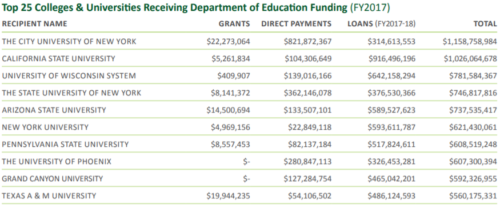
If you wonder why college costs are so high, and why they keep rising, one answer would be the substantial amount of federal aid that goes to these schools, either in the form of grants to the schools or in loans to the students. If philanthropists interested in higher education are going to spend their grant money wisely, they ought to know how much federal aid their targeted schools are getting.
Open The Books has provided a valuable resource for donors with a report, written by Adam Andrzejewski and Thomas W. Smith, on how much money the Department of Education gives to higher education.
Overall, Open The Books found that the Department of Education ladled out around $18 billion in the 2017-18 fiscal year in grants, direct payments, and loans. Here are the ten universities receiving the most Department of Education money:

Note which schools aren’t on the list: the Ivy League schools famed for their massive endowments. Of the schools that are on the list, all are schools which have many campuses, including those such as Penn State and Texas A&M where the main campus is the largest slice of their university systems. The three largest university systems, the City University of New York, the State University of New York, and California State University,[1] are three of the four largest recipients of Department of Education aid. At least two of the schools on the list—New York University and Texas A&M—are large enough and wealthy enough that they have branch campuses in the Middle East.
Two of the top ten schools, Grand Canyon University and the University of Phoenix, are for-profit schools. They don’t get grants from the Department of Education, but do get direct payments to students and student loans.
Andrzejewski and Smith then have fun discussing schools you didn’t know existed but whose students get direct payments from the Department of Education and federal student loans, including schools devoted to building wooden boats, training people to repair refrigerators, and preparing people to run games at casinos.
The authors note that most seminaries have students who get federal student loans. They calculate that, between fiscal years 2015 and 2018, the three religious education schools that had the largest amount of federal student loans were Fuller Theological Seminary ($77.8 million), Asbury Theological Seminary ($32.9 million), and St. Vincent’s College ($30.1 million). Fuller and Asbury are nondenominational Protestant schools, and St. Vincent’s was the only Catholic school on the list.
Finally, the authors note the 50 best-paid Education Department employees. Secretary Betsy DeVos, who makes $199,400, is the best-paid employee, of course, but there are two other Education Department employees who make over $195,000 and the 50th best paid employee in the department makes over $180,000.
Given this information, what should program officers who fund higher education do with it?
First off, remember that nonprofits tend to give to universities rather than individuals. The recent grants of Robert F. Smith to Morehouse College [LINK] eliminating student loan debt for graduating seniors and Michael Bloomberg to Johns Hopkins ensuring that Hopkins students don’t have to take out loans are unusual because they’re meant to help students directly.
Open the Books might help you find schools with high tuition bills and low amounts of government aid. These schools would be better recipients of your aid than places where the government pays a larger portion of tuition.
However, as Jacqueline Pfeffer Merrill wrote last week, subsidizing tuition is not the best use of education grantmaking. As I wrote in my study Games Universities Play, there are much better ways for donors to use their grants:
There are many useful ways donors can support colleges—as long as you don’t do anything to assist college endowments. For as Washington Post columnist Jay Mathews notes, a large endowment is no signal of educational quality.
“I see no sign that life-enhancing research correlates with endowment size,” Mathews writes. “Our universities are admired throughout the world, but I can think of better things to do with $36 billion than making Harvard look good.”
[1] Remember, the University of California is separate from the California State University system.